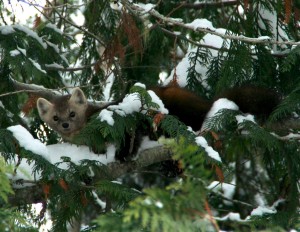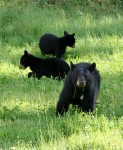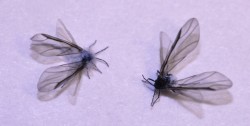Spring is birthing time for many animals in order for the young to have adequate time to grow and develop before the onset of winter. For many animals, that means mating in mid- to late winter. Raccoons begin mating in February and March and give birth in April.
Larger animals such as elk and moose mate in the fall and give birth in the spring since the young require a long gestation period.
What about a small animal like a pine marten? They mate in July and August and give birth in late March and April. However, their gestation period is only 27 days.
Pine marten are one of nearly 100 mammalian species that exhibit a reproductive strategy called delayed implantation. Once the egg is fertilized and grows to the blastocyst stage (a microscopic ball ofroad cells), development is suspended. The embryo free-floats in the female’s uterus until her body signals for it to implant and continue development.
For pine marten, the delay allows young to be born in the spring instead of the fall which provides them time to learn survival skills before winter.
Black bears are one of the more well-known mammals to exhibit delayed implantation. They mate in early summer and with the aid of delayed implantation the embryo implants in mid-November or December. Then after a gestation of 60-70 days the young are born in January or February. If the female didn’t have an ample supply of summer or fall food, her body will abort the fetuses before implantation because there aren’t enough reserves to support a litter.
Black bears utilize a type of delayed implantation called obligate delay. Obligate delay lasts for varying amounts of time from weeks to nearly a year.
On the long end of obligate delay are fishers and seals. Fishers are pregnant all year except for two weeks. They mate in March or April and give birth in February or March of the following year. The females mate within two weeks of giving birth, delay implantation for 10 months and then implant the embryo 30 days before the young are born.
Similar to fishers are seals. They come ashore once a year to give birth and breed before returning to the sea. The embryo remains in dormancy for several months to ensure the seal gives birth the same time the following year when all the seals are ashore.
On the short end of obligate delay are mink. They delay implantation one to six weeks. Scientists are uncertain why the delay is short but have two theories. The first is that delayed implantation is an inherited trait and mink are slowly losing it. The second theory is that delayed implantation allows superfetation (permits the female to ovulate and conceive while pregnant).
During breeding season, female mink mate with multiple males. Superfetation allows the female’s eggs to become fertilized with each mating male. Each fertilized egg develops to the blastocyst stage and then suspends development until the end of breeding season. Then all the embryos implant at the same time so they are all born at the same time.
Similar to mink are striped skunks. Females breeding earlier in the breeding season have the longest pregnancy due to delayed implantation. Those breeding at the end of the season have a shorter pregnancy. Ultimately, gestation ranges from 55 to 77 days with the young born from May to mid-June.
The reasons for delayed implantation range from nutrition in black bears to seasonal delays in seals. Other animals exhibit delayed implantation for other reasons, some known and unknown, which I’ll write about in next week’s column.





